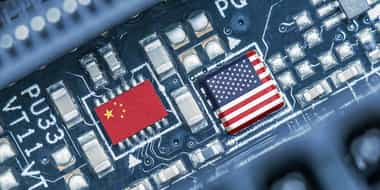Jan 12, 2023
The semiconductor chip shortage has been wreaking havoc on industries and economies for the better part of two years. Chips are omnipresent, integral to the smooth running of society. With end uses across the automotive, healthcare, computing, and industrial industries, the supply-demand issue has created nothing short of a global snowstorm. Shortages caused Apple to delay the launch of the iPhone 12 by two months, and the automotive industry saw revenue losses of $100 billion in 2021.
The chip shortage is a highly disruptive and ongoing issue for manufacturers the world over, which we’ll be examining further below. Despite the difficulties created by the shortage, the overall global semiconductor chip market is still primed for growth. Estimated to be $585.4 billion in 2022, BCC Research anticipates the market will reach $882.1 billion by 2027, growing at a CAGR of 8.5%.
The Covid-19 pandemic was the main catalyst for the chip shortage, though rumblings had been occurring for some time. Two successive fires in Japanese chip plants, one occurring in October 2019 and the other in March 2021, further complicated the issue.
When Covid-19 hit China, the first wave of supply issues unfolded. Factories were shut down to deal with the pandemic, meaning manufacturing came to a standstill. As the pandemic took hold globally, the issue worsened. The flurry of demand for PCs, cameras, keyboards, and displays that came with work-from-home measures added further pressure. The result was a major chip crunch as demand remained high for consecutive quarters.
As a result of the bottlenecks, tech companies have begun investing in the development of chips. In August 2022, Samsung announced that it would invest $206 billion over the next three years into semiconductors, biopharma, AI, and robotics.
Apple is now using its M1 chip in new iPads and Macs, and a report by Nikkei Asia suggests that Google is developing its central processors for use in the CPUs of its Chromebook laptop from 2023. These actions come as a direct result of the disruptions, but in the long term, they’ll contribute to a securer supply chain and a stronger market.
If the current global situation wasn’t challenging enough for manufacturers, the outbreak of the Russia-Ukraine war unleashed further pressure. Russia produces about 40% of the world’s palladium, while Ukraine produces about 80% of the world’s supply of neon. Both are integral raw materials used in semiconductor manufacturing. While inflation and indirect supply chain lags are manageable in the short term, the potential long-term impact of the war remains unclear.
The chip shortage won’t disappear anytime soon. But amid the ongoing difficulties, the global market for semiconductor chips is primed to enter a period of robust long-term growth. A number of factors are contributing to market expansion, one being the pivotal role chipsets will play in the development of AI. Tech giants like Google, Apple, and Amazon have entered the AI hardware market in the past decade. In a race to compete, other software players are attempting to penetrate the market through partnerships and collaborations. Investments in AI research and development by these key players will bolster the entire AI ecosystem – including the market for semiconductor chips.
AI chips are comprehensive and complete, made of silicon, and used for machine learning. The advent of quantum computing and the rising use of AI chips in robots are driving the global artificial intelligence chip industry. As AI technology advances, substantial growth prospects will emerge.
5G is the connectivity of the future, but it will be a few more years until it gains a comparable market presence to 4G. The robust capacity, latency, penetration level, and speed will nevertheless ensure that 5G will have a higher and faster adoption rate than its predecessors.
The 5G chipset market will witness gradual to significant growth across its varied application segments. In consumer electronics, telecom infrastructure, and public safety and surveillance applications, the market will experience positive growth. Another notable emerging trend will be the use of 5G chips in the automotive sector. The adoption of 5G in cars will help provide the connectivity link between vehicles with cell phones, other cars, and a host of internet-connected devices. Automobiles will be transformed into data centers on wheels with the aid of 5G. According to the GSM Association, a third of the world’s population should be covered by 5G by 2025. The accelerating pace of 5G wireless network deployments will create lucrative new markets for chip makers in the coming years.
While there’s a strong long-term demand for chips, the persistent labor shortage could dampen projected growth in the semiconductor industry. Taiwanese chip company MediaTek is looking to expand its US presence, however plans are being encumbered by the skills shortage. According to a whitepaper by Eightfold.ai, the US alone will need 70,000-90,000 more workers by 2025 to meet the most critical workforce needs for new fab facilities.
A need for scientists is a significant issue in China particularly. In 2021, the average salary within the Chinese semiconductor industry increased by 9% in the heat of the US/China tech rivalry. Peking University and Shenzhen Technology University have set up a semiconductor school to train chip engineers to address the shortfall.
BCC Research’s recent report evaluates the current and future situation for semiconductor chips. With the past and present volatility of the industry, coupled with the growing need for chips, gaining a thorough insight into the market has never been more crucial. The report helps enrich decision making and assists in avoiding pitfalls that are common in the current crisis.
To download your complimentary report overview, click here.
We also offer library memberships that provide access to the full scope of reports within the semiconductor manufacturing category. Please get in touch with a helpful member of our team below. We’d be happy to discuss the benefits of membership further.

Olivia Lowden is a Junior Copywriter at BCC Research, writing content on everything from sustainability to fintech. Before beginning at BCC Research, she received a First-Class Master’s Degree in Creative Writing from the University of East Anglia.

Biophotonics: Technologies and Global Markets (PHO024B)

Global Trade: A Strategic Shift The global trade environment is undergoing a dra...

The global demand for cutting-edge materials continues to rise, and at the foref...

We are your trusted research partner, providing actionable insights and custom consulting across life sciences, advanced materials, and technology. Allow BCC Research to nurture your smartest business decisions today, tomorrow, and beyond.
Contact UsBCC Research provides objective, unbiased measurement and assessment of market opportunities with detailed market research reports. Our experienced industry analysts assess growth opportunities, market sizing, technologies, applications, supply chains and companies with the singular goal of helping you make informed business decisions, free of noise and hype.